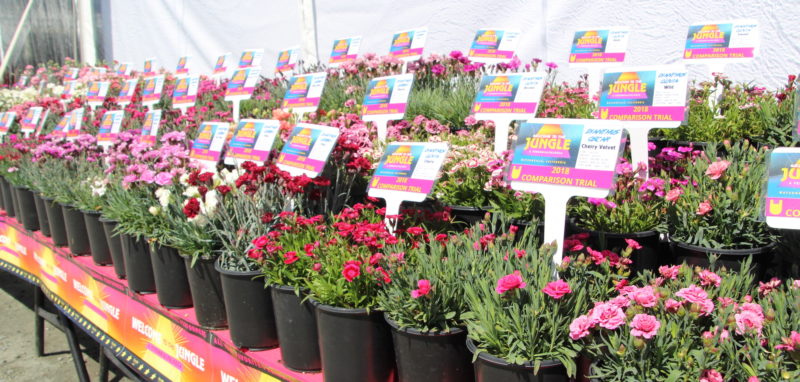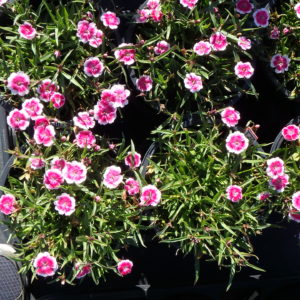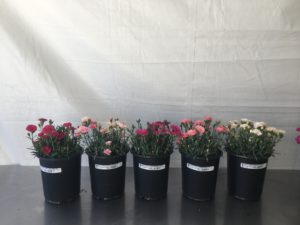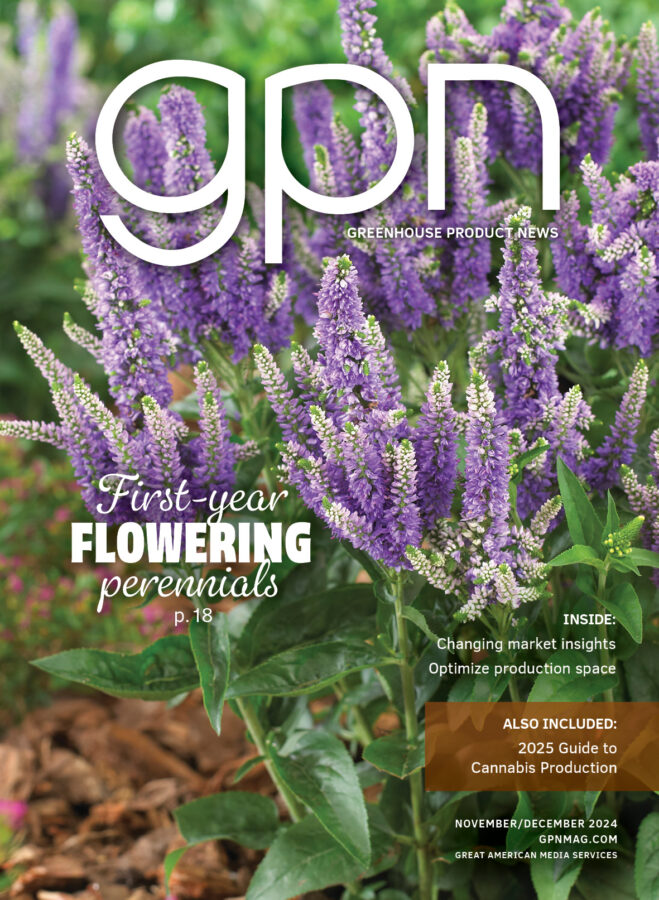
Comparing a Whole Lotta Dianthus
Since 2016, Pacific Plug & Liner changed our efforts to focus solely on the perennial market. We have a large listing of perennial products but also have eight focus crops as part of our grower solutions program called Planthology. One of the eight focus crops is dianthus, so it was natural for us to want to trial this group. Dianthus is a major focus for us in part due to our climate; for fall programs it is hard to beat to 60 to 70º F average day temperatures during July and August when rooting is taking place.
Trials are important to Pacific Plug & Liner, not only for our own growing experience but to learn more about the products we offer so we can provide better growing information to our customers. Each year we hold a comparison trial of one genus, displaying the trial at the California Spring Trials but also evaluating the trial before and after the event. We always pick a genus that can bloom near that timeframe but never force them for the show. Dianthus was a major undertaking with so many varieties currently on the market. For this trial, we stuck to vegetative varieties to keep things a bit simplified but also to align with our program focus, which lists vegetative varieties only. I giggle to myself when I say simplified because even just listing vegetative varieties we still had over 130 varieties! Week 40, 2017, was target plant date for this trial to have enough time to bulk before winter conditions set in. For a summarized list of varieties, final sizes, flowering times and more, go to: https://bit.ly/2McxBaZ.
Data and photos speak for themselves, so I like to spend a fair amount of time summarizing all of the photos and measurements we collected into one place. This helps me when writing about the topic, but it is a great resource for anyone interested in dianthus! To get your hands on this document, go to: https://bit.ly/2vKgG5h.
TRIAL CONDITIONS
All crops were planted into 2.5-quart sized pots using a 72-cell liner, which were produced at Pacific Plug & Liner from unrooted cuttings sent to us by various farms. Unrooted cuttings were stuck between weeks 29 and 33 of 2017, depending on when product was available. Soil used was comprised of peat, perlite and bark, mixed with a slow-release fertilizer.
This trial was grown outside in Watsonville, California, on the ground, in traditional perennial growing fields with overhead irrigation and zero supplemental lights or heat. Watsonville is known for its mild coastal climate, with day temperatures usually in the mid 60s to low 70s and night temperatures in the low to mid 50s, perfect dianthus weather! In late October 2017 we did have a few warm days with temperatures getting in the high 90s, but our night temperature still dropped to the upper 50s, so the dianthus remained happy campers. By November, temperatures started to drop with day temperatures in the mid 50s. Early in the month, we had had our first nighttime frost. This caused some light foliage damage of many of the pot types including Odessa, Olivia, Oscar, Sunflor and SuperTrouper series but nothing these varieties could not grow past. Temperatures continued to drop January through February. Then we started to warm up a little for spring, which got us back to our average. As varieties started to flower, we removed spent flowers to keep the crop fresh for the California Spring Trials display. At the time of Spring Trials, week 16 of 2018, we were just below 13 hours of day length.
We had a few goals in mind when setting up this trial. One goal was to see the breadth of what is currently on the market; just from our display, one could see it is a bit overwhelming and this was not even everything on the market! Another goal, of course, was to compare varieties against each other. With so many different types of dianthus on the market, making side-by-side comparisons was a challenge. To help with this, we broke the trial into two groups, pot types and perennial types.
POT TYPE DIANTHUS
In this category we trialed the following: Dianthalot series (Selecta), Everlast series (Selecta), Odessa series (Dümmen Orange), Olivia series (Dümmen Orange), ‘Pink Kisses’ (Selecta), Sunflor series (Dümmen Orange) and SuperTrouper series (Selecta). These all had a similar appearance, a traditional pot carnation look, with the exception of the Olivia series; this one has wide leaves and single flowers versus narrow leaves and mostly semi-double to double flowers of the rest.
Uniformity in a Series
Is it a series or a collection? Often plants are grouped together under a series name. Growers might make an assumption that because they are all under one series name they grow exactly the same, including plant size and bloom times. This can be true for some, but it is not true for all. Of the above mentioned series, the following series had great uniformity: Dianthalot, Olivia and Oscar. The Dianthalot series only has two varieties, so a little easier to match but they are identical. Selecta promotes Oscar as being hyper-uniform and I have to say that this is true. Series that did not show uniformity were Everlast, Odessa, Sunflor and SuperTrouper. Both Sunflor and SuperTrouper have so many varieties I can see it being hard to get them all matching.
Bloom Times
Pot dianthus or carnations are generally easy to program and need no vernalization in order to bloom. All varieties tested bloomed very well and continued to bloom through about week 10; at this point, we removed spent flowers to encourage further flower production. This group started to bloom between weeks 2 and 5 of 2018, averaging between 12 and 15 weeks to bloom when fall planted. If spring planted, this time would reduce. The Olivia series takes the prize as earliest to bloom; this series started showing her pretty flowers in week 2 of 2018. Again, this series is very different in appearance from the rest of the varieties tested. The remaining varieties were blooming around the same period.

Sizing
The pot dianthus we trialed averaged at 6.5 inches tall; shortest were 4 inches tall, while the tallest variety was 11 inches tall. In general, the Olivia and Oscar series were the shortest of the bunch, while the Odessa series was the tallest of the bunch. Volume wise, the Dianthalot series were nearly busting at the seams filling the 2.5 quart with no issues and could easily fill bigger pots. ‘Pink Kisses’ was one of the smaller pot varieties trialed and would be a great variety for quarts and 4-inch pots. Now for the more challenging category!

PERENNIAL TYPE DIANTHUS
In this category we trialed the following: American Pie series (PlantHaven), Beauties series (Dümmen Orange), Cadence series (Green Fuse Botanicals), Constant Beauty series (Green Fuse Botanicals), Constant Promise series (Green Fuse Botanicals), Devon Cottage series (PlantHaven), Early Bird series (PlantHaven), the oldie but goodie ‘Firewitch’, Kahori series (Dümmen Orange), Mountain Frost series (Darwin Perennials), Promotional Line series (PlantHaven), ‘Red Beauty’ (Darwin Perennials), Scent First Pot and Tall series (PlantHaven) and Star Double and Single series (PlantHaven). Wow, that was a mouthful! In the perennial category, we trialed 60 varieties, 32 of these were Whetman varieties from PlantHaven; these genetics are definitely dominating the marketplace by number. There are some up and comers in the perennial category with Green Fuse releasing three series recently and Darwin releasing their new landscape Mountain Frost series.
Unlike the pot dianthus category, there is a wide range of looks in the perennial category. So it is even more of a challenge to compare these. I further broke this category into subgroups to help with this. I initially looked at trying to divide by breeding lines, but this was too hard to follow with so many hybrids on the market; simplified subgroups it is! I made three subgroups based on appearance only. First up is pot-like appearance but perennial hardiness; this includes Cadence, Constant Beauty and Constant Promise, more about these later, and the Early Bird series. Then there are the groundcover-like or very short varieties; these include the Beauties series, Kahori series, Mountain Frost Series, ‘Red Beauty’ and Star series. Last, but not least, are the very traditional pinks category. These all have the blue-green foliage and mostly double flowers, with the exception of the American Pie series with its large single flowers and ‘Firewitch’ with small single flowers. Traditional pinks ranging from short to tall, we have Scent First Pot Series, ‘Firewitch’, Scent First Tall Series, Promotional Line Series, Devon Cottage Series and American Pie Series.

Uniformity in a Series
My initial thought was finding a uniform series within this category would be more challenging than with pot types. I have to say that for the most part all series, with the exception of Mountain Frost and Promotional Line, were close to uniform. Mountain Frost series and Promotional Lines were very different from each other versus the other series, which only had slight differences in height and bloom times. The Mountain Frost is definitely more of a collection versus a series. In doing some research, these were selected for landscape performance; this could have been more the driving force for selections versus creating a uniform series. The Promotional Line from PlantHaven is touted as a collection of unique varieties that should be showcased on endcaps, so it is understandable why these are not matching. The series with best uniformity in our trials was the Cadence series.
Bloom Times
Traditionally perennial type of dianthus are not as programmable as the pot type when it comes to bloom time. These generally need or benefit from vernalization. That being said, the three new series from Green Fuse — Cadence, Constant Beauty and Constant Promise — do not need vernalization and are fully programmable because of this and being day neutral. These caught my attention because they have the appearance of a pot type carnation but hardiness of Zone 4, which is much lower than the Zones 5-6 other pot carnations are listed as. I reached out to Green Fuse to be sure I was reading the information correctly. Sure enough I was; these have been bred to not only hold up to extreme winter conditions but also perform well in the heat, both warm day and night temperatures. Definitely a series to try for those looking for garden performance.

Bloom time is an important factor for growers; with such a wide range of varieties there is a corresponding wide range of bloom times, which is good so that growers can spread their sales window by using different varieties. In general, we saw the Kahori, Cadence, Constant Beauty, Constant Promise and Early Birds all bloom on the early side between weeks 1 and 4 of 2018 with Kahori being the earliest. Devon Cottage, Mountain Frost, Promotional Line and the Scent First were more midseason blooming between weeks 5 and 9 of 2018. We saw some issues with some varieties of Mountain Frost not blooming well. I contacted Darwin about this and they have never seen this, saying these varieties bloom well even without vernalization. We are going to trial these again to see how they do in 2019. For late season varieties, we had the American Pie series and the Star Doubles and Singles, blooming between weeks 10 and 15 of 2018.
This is a general observation; there were some outliers in some of the series. This information is available in the data sheet mentioned earlier in the article.
Sizing
In this category, there was a wide range of sizes so growers can find a variety to fit every need. Short varieties include Beauties, Cadence, Constant Beauty, Constant Promise, Early Bird, Kahori, Mountain Frost, Scent First Pot, Star Double and Star Single. These range in height from 1 to 8 inches tall, including flower height. Medium varieties include ‘Firewitch’, Promotional Line, ‘Red Beauty’, Scent First Tall, ranging in height from 9 and 12 inches. On the tall side, we had American Pie and Devon Cottage at 13+ inches in height. As with the bloom times there are some outliers within the series, mainly Pinball Wizard being on the tall side, which makes sense since it is more of a Devon Cottage type. In addition, some of the Mountain Frost varieties, Pink Carpet and Rose Bouquet, are on the medium side versus short.
Well, this wraps up the 2018 Dianthus Comparison trial at Pacific Plug & Liner. It was a huge undertaking. We hope you take time to view the presentation with photos throughout the season plus sizing measurements, as this is much more detail than I could ever give in an article. Curious what variety was the best? That is impossible to answer with so many being tested! We did pick our favorites in each series; this was based on plant habit, overall appearance and number of blooms. This can also be seen in the document mentioned earlier.
Our Perennial Passion at PP&L brings you grower solutions with the support you need for best success along with exclusive groundbreaking varieties. Trials like this provide us valuable information that we can pass along to our customers and help us to focus our offerings that we provide to the marketplace. For availability on all of the trialed dianthus varieties, please be sure to check our Liner-Bility tool that features 72 weeks of forecasted availability, located here: www.ppandl.net/avail-info/ppl%20availability.xlsxm.


 Video Library
Video Library 



















